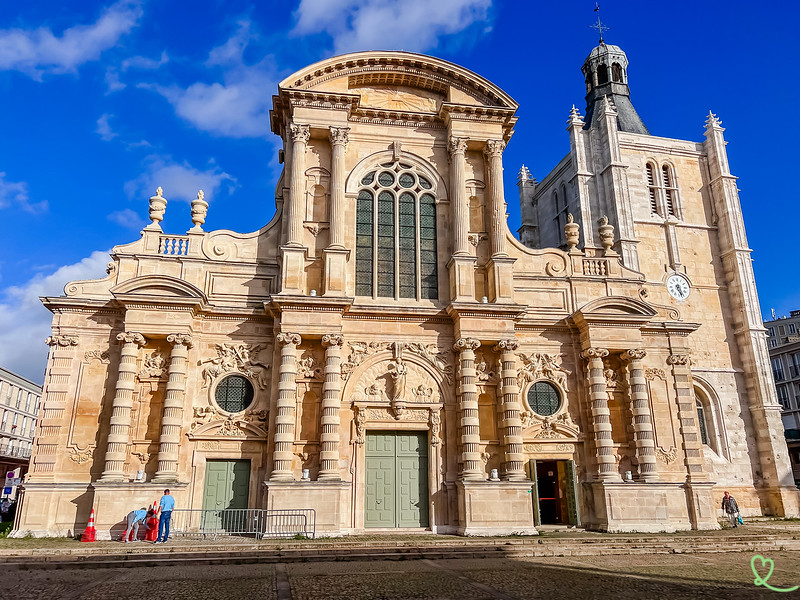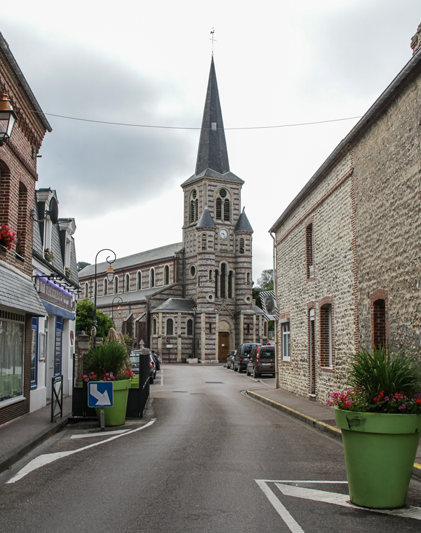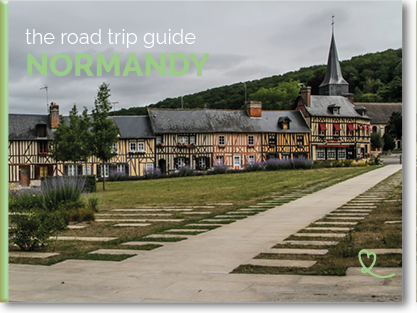If you plan to visit Le Havre Cathedral during your stay, you’re in for a surprise!
Surely one of the smallest cathedrals in France, it is one of the few buildings in the city to have survived the bombardments of the Second World War.
In this article, we tell you all about theatypical history of this place, with tips and photos to help you prepare for your visit.

This guide is completely independent, based on our experiences. We visited the region anonymously, making our own choices and paying our bills in full.
Why visit Le Havre Cathedral?
Is Le Havre Cathedral worth it? Our opinion:
Although Le Havre Cathedral may not be impressive (just 62.9 m long, 27.3 m wide and 13 m high, a far cry from the 151 m of neighboring Rouen Cathedral), it is not without interest, particularly from an architectural point of view.
In fact, it’s a combination of the different architectural styles of the 16th and 17th centuries. The Gothic-inspired tower is joined by a Baroque-style main facade, while the side facades are in Renaissance and Classical styles…
This building is an art history lesson in itself! This is one of Le Havre’s must-see places.

Why is Notre Dame Cathedral famous?
Because this is the church where our mother did her catechism…
On a more serious note, the Cathedral occupies a special place in the hearts of the people of Le Havre, and in the city’s history, because it is one of the few buildings not to have been razed to the ground after the terrible bombardments of September 1944.
While 82% of the city was destroyed in the space of 5 days, the Cathedral, though damaged, did not collapse.
Auguste Perret, the architect in charge of rebuilding Le Havre, decided to save it and even push back the Rue de Paris, one of the city’s main streets, to give the Cathedral a square worthy of the name.
At the same time, he commissioned the construction of St. Joseph’s Church a few hundred meters away, in a resolutely modern style, creating a striking contrast between these 2 religious buildings.
Don’t confuse Le Havre Cathedral with Saint Joseph’s Church
Having lived next door to these 2 places of worship since our youth, we’ve regularly come across visitors looking for the Cathédrale Saint Joseph, or the Cathédrale Perret in Le Havre.

On the one hand, there’s Notre Dame du Havre Cathedral, a large church built in the 16th and 17th centuries and elevated to Cathedral status in 1974, and on the other,Saint Joseph’s Church, a masterpiece of modernism built by Auguste Perret from 1951 to 1957.
It’s not hard to imagine why Pope Paul VI preferred the much more traditional church on rue de Paris to the revolutionary building on boulevard François 1er, so far removed from the codes of Catholicism at the time. If you’d like to find out more about Saint Joseph’s church, read our full article.
700 metres and four centuries separate these 2 religious buildings!
Both are well worth a visit, even if you only have a day’s stopover at the cruise port of Le Havre.
WHERE TO STAY IN Le Havre
Our favorites: neighborhoods and hotels
On the waterfront:
Hilton Hotel with its modern decor and balconies – see prices, photos and availability.
Downtown, in the heart of Perret architecture:
Hôtel Pasino, for ultra-spacious rooms – See prices, photos and availability
Hotel Vent d’Ouest, a charming place to stay – See prices, photos and availability

History in brief
- February 7, 1517: François I, King of France, orders the construction of a fortified port at Grâce, the birthplace of Le Havre.
- 1520-1522: First wooden chapel with thatched roof, destroyed by a large wave on January 15, 1525.
- April 10, 1539: Laying of the foundation stone for the second Notre Dame church, following a donation from the King. It was swept away by the religious wars that shook Le Havre and the rest of France.
- April 28, 1575: laying of the foundation stone for today’s Notre Dame church, which was completed in 1646.
- 1637: Cardinal Richelieu donates the church’s great organ.
- 1918: the building is listed as a historic monument
- September 1944: the church is partially destroyed by Allied bombing raids
- 1952: resumption of Sunday masses
- July 6, 1974: Pope Paul VI raises the church to the rank of Cathedral

Access – Notre Dame Cathedral, Le Havre, France
Where to find Le Havre Cathedral
- In downtown Le Havre
- Along rue de Paris, between Hôtel de Ville and the arch of the catèbe containers
OUR ADVICE FOR RENTING A CAR IN Normandy
- Compare prices on our preferred platform: DiscoverCars – one of the best rated sites.
- Choose a car that is comfortable enough (distances can be long) but compact (some parking lots and villages are narrow).
- Think of thecomplete insurance (some roads are tortuous and narrow).
- There is a lot of demand, book it early.

How to get there
Once you’ve arrived in Le Havre, a network of buses, streetcars and scooters will enable you to quickly reach the cathedral and discover the city. Getting around the city is easy, and parking is relatively straightforward.
- Bus: lines 2, 3 and 7 – Cathédrale stop
- Tramway: Hôtel de Ville – 500 metres
Parking
The Cathedral doesn’t have its own parking lot, but you can easily find parking in the immediate vicinity. In adjacent streets, you’ll have to pay to park, but on the way to Southampton Quay or the waterfront, you’ll be able to park for free. You’ll then be just a few hundred meters from the entrance to the Cathedral.
Practical advice: duration, schedules, eating…
Best time to visit Le Havre Cathedral
Le Havre Cathedral is never crowded. You’ll just have to avoid Wednesday and Saturday evenings after 6pm, as thechurch service starts at 6:30pm.
Visits should also be avoided when a funeral is in progress.
How long to visit the castle and main difficulties
Allow half an hour to tour Le Havre Cathedral, admire its facades, stained glass windows and religious paintings.

Advice on how to visit
Take a good look at thetangle of architecture on the outer facades, before entering the Cathedral. You can then follow the Way of the Cross we’ll tell you about next, or let your instincts guide you!
USE OUR GUIDE TO PLAN A
DREAM TRIP TO Normandy
All the information you need for your trip:
- 8 maps that make planning easier
- 160+ pre-selected locations
- Practical advice
- 300+ photos to help you choose

Schedules and prices
The church is open daily from 10am to 6pm, except for ceremonies. Access and visits are free of charge.
Catering
As the cathedral is in the center of town, there are plenty of restaurants to choose from.
See our article on the city’s best restaurants.
Architecture: if the Cathedral’s facades could speak…
The Cathedral’s construction period spans from 1540 for the tower to 1638 for the main portal. Almost a century of artistic influences condensed in this building.
La Tour
The bell tower, the oldest part of the building, dates back to 1540, and was built in Vernon stone (as opposed to Caen stone for the rest of the Cathedral, you’ll notice the difference in hue, especially since its renovation in 2021). It features a number of Gothic-inspired ornaments, a style in decline at the time under the influence of the Italian Renaissance.

Side facades
The 2 side façades are in Renaissance and Classical styles, with balustrades, pilasters, sculptures, oeil-de-bœuf…

The main façade
A new change of style, with the main (western) façade in typical Baroque style, with pediments, columns, scrollwork decoration… This artistic movement, which will also be found in music (Bach, Handel…), is a more theatrical, grandiose reinterpretation of the Renaissance. Take the time to look at each ornament – this façade is no exception, don’t you think?

Interior: mirroring the city’s history
The ravages of weather
Maintenance of Le Havre Cathedral is particularly delicate. It is built mainly of limestone: Vernon stone and above all Caen stone, used in many buildings in France and the UK (Tower of London, St. Paul’s Cathedral, London…).
Limestone is particularly sensitive to humidity, sand and cold, and it will not have escaped your notice that it can sometimes rain in Le Havre (if rarely…), that we are by the sea and that the wind is an integral part of its charm…
Both the exterior and interior have undergone numerous renovation campaigns (the latest in 2021), with varying degrees of success depending on the era and technology used.
The destruction of 1944
During the bombing raids of September 1944, the future Cathedral was heavily damaged:
- only 2 stained glass windows can be preserved
- the great Richelieu organ is destroyed
- a large part of the nave was destroyed (from the façade to the transept)
- one of the bells crashes

Although the reconstruction work was of the highest quality in its context, it did alter the Notre Dame du Havre church.
The chapels
Of the 9 chapels that existed before 1944, only 6 remain today:
- The Saint-Sébastien chapel , which houses the tabernacle (the ciborium, the sacred vessel that holds the consecrated hosts).
- Chapel dedicated to the Virgin Mary with its statue of the Virgin and Child
- the chapel of the Holy Name of Mary, with a painting by Sobeck dating from 1836
- Former chapel of the Blessed Sacrament, home to the altarpiece of the church of Sainte Cécile, destroyed in the 1944 bombardments.
- Former Saint Vincent de Paul chapel
- Chapelle du Sacré-Coeur with its Christ on the Cross

The stained glass windows
Blown out during a first bombardment in 1941 and mixed with the town’s debris in 1944, only 2 stained glass windows were saved. They can be seen at the entrances to the sacristy.
The other stained glass windows were created by master stained glass artist Michel Durand in 1974, in a figurative style depicting :
- the mass given after the liberation of Le Havre by royal troops following the English invasion in 1563
- a visit by Henri IV in 1603 to the rue de Paris in which the Cathedral is located (and the family store, but that’s beside the point…).
- the Virgin Mary (offered by the city of Le Havre)

The Way of the Cross
The Cathedral’s Stations of the Cross were installed on the transatlantic liner the Normandie, commissioned in 1935 and requisitioned by the Americans in 1941, before being irretrievably destroyed by an accidental fire in 1942.
The wooden panels you can admire in the cathedral were weighted down with lead so they wouldn’t move in a storm!
The organ
The original great organ was donated by Cardinal de Richelieu, governor of the city in 1637. Completely destroyed during the bombardments of 1944, it would take almost 36 years for it to be reconstructed from the debris and existing photos. Only a few original parts remain, including the 2 sculptures you can see at the base of the organ.

A sloping forecourt
On your way to the Cathedral, you’ll notice that the church is below the level of the Rue de Paris. Here too, we have to look to history.
When Le Havre was being rebuilt, it was decided to build on top of the rubble, as evacuating it was impossible given the immensity of the task. As the church survived the bombardments, it is now a few dozen centimetres lower.
It should be noted that this square did not have the same dimensions before the war, but was enlarged with the new design of the town, which moved the rue de Paris several meters.
PLAN YOUR TRIP TO Normandy
Inspiration destinations
- Deciding where to go in Normandy – the best destinations
- Our weekend ideas: best-of, romantic, unusual, seaside, luxury, family
- 16 seaside hotels in Normandy
- The most beautiful charming hotels in Normandy

Best of

Practice
- Where to stay in Normandy – best places and hotels
- See our tips for renting a car at CDG airport, Orly airport, Beauvais airport, Caen, Rouen, Bayeux…





